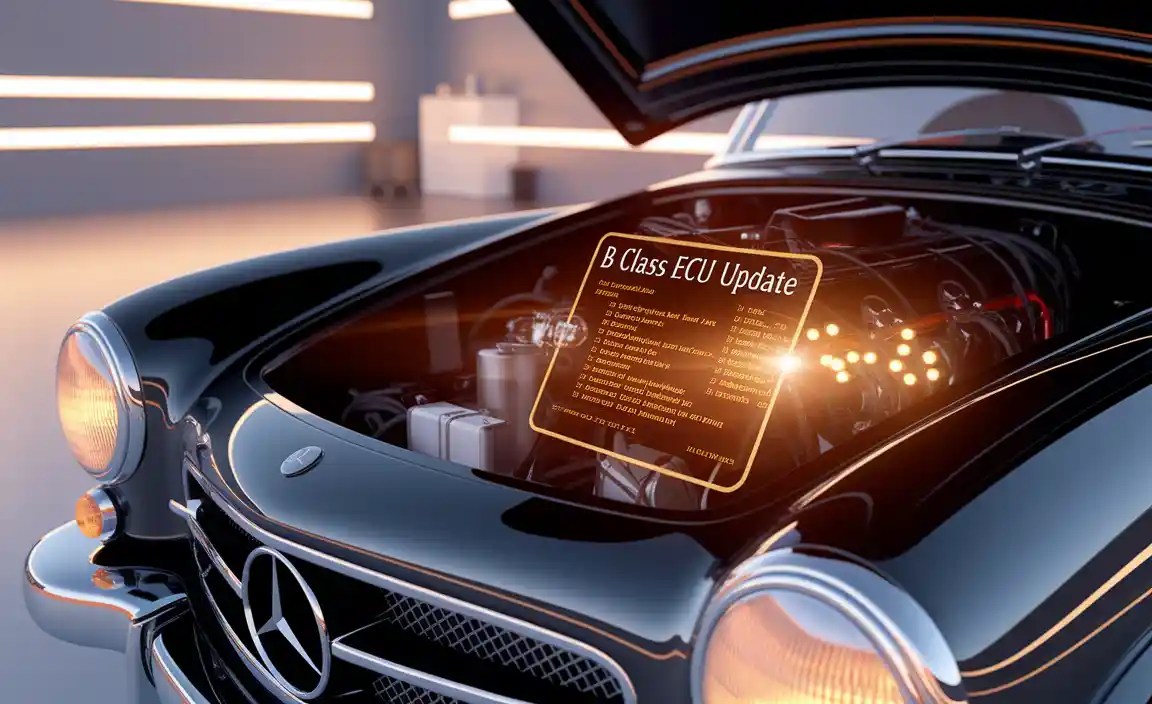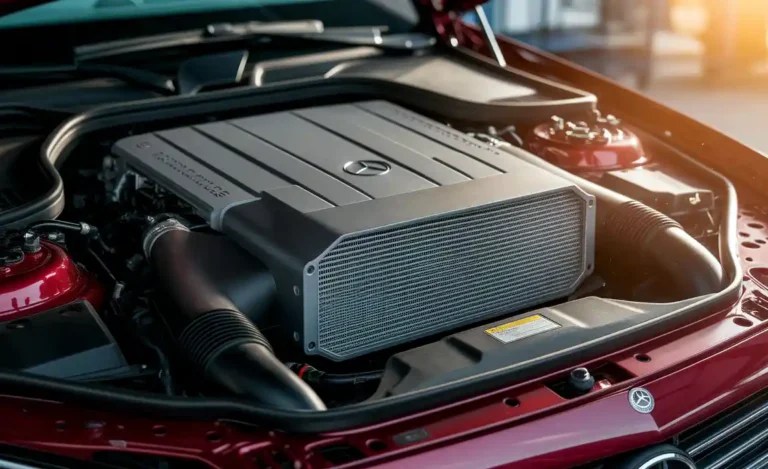B Class ECU Update: Ultimate Refinement
For Mercedes-Benz B-Class owners, a B Class ECU update is a software enhancement that optimizes engine performance, fuel efficiency, and overall driving dynamics. It’s a straightforward process to keep your vehicle running at its best, ensuring a smoother, more responsive, and refined driving experience.
When you first get a Mercedes-Benz B-Class, it feels incredibly refined and responsive. Over time, though, you might notice subtle changes or simply wonder if your car is performing at its absolute peak. One of the keys to maintaining that initial perfection, or even enhancing it, is a B Class ECU update. Think of the ECU, or Engine Control Unit, as the brain of your car. It manages everything from fuel injection to ignition timing. Keeping this brain updated is like giving your intelligent vehicle a fresh perspective, ensuring it runs smoothly and efficiently. We’ll guide you through what an ECU update is, why it matters, and what you can expect.

What is a B Class ECU Update and Why Does It Matter?

The Engine Control Unit (ECU) is the central computer that governs your Mercedes-Benz B-Class’s engine and its various functions. It precisely controls parameters like fuel delivery, ignition timing, idle speed, and emissions. Manufacturers release software updates for the ECU to refine its operation, improve performance, enhance fuel economy, or even address minor drivability issues discovered after a model’s release. For your B-Class, a B Class ECU update is essentially a software patch that fine-tunes the engine’s performance and responsiveness.
Think of your smartphone; you regularly get software updates that fix bugs, improve camera performance, or add new features. An ECU update works in a similar fashion for your car. Mercedes-Benz, like other major automakers, continually gathers data from vehicles on the road and may identify opportunities to optimize the software. These updates are designed to:
- Improve Engine Performance: Enhancements can lead to a more responsive throttle, smoother acceleration, and a more predictable power delivery.
- Boost Fuel Efficiency: Optimized engine mapping can help your B-Class consume fuel more efficiently, saving you money at the pump.
- Reduce Emissions: Updates can ensure your vehicle meets the latest environmental standards and operates with fewer emissions.
- Address Minor Drivability Issues: Sometimes, owners might experience slight hesitations or rough idling. An ECU update can resolve these common, albeit minor, problems.
- Enhance Overall Refinement: The cumulative effect of these improvements contributes to a smoother, quieter, and more pleasant driving experience, true to the Mercedes-Benz promise of refinement.
It’s crucial to understand that an ECU update is not a performance tune-up in the aftermarket sense, aiming for drastic horsepower gains. Instead, it’s about restoring or enhancing the vehicle’s intended operational efficiency and refinement as designed by the manufacturer.
When Should You Consider a B Class ECU Update?
While an ECU update is a beneficial maintenance task, there are specific times when it makes the most sense for your B-Class.
Regular Servicing and Recalls
The most common time to receive an ECU update is during routine scheduled maintenance or a manufacturer recall. Dealerships and authorized service centers will typically check for available software updates for your vehicle’s control modules when it’s in for service. If an update is available and deemed beneficial or necessary, they will often perform it as part of the service. Manufacturers may also issue recalls for specific software issues, in which case the update would be free of charge.
Experiencing Specific Issues
If you notice any of the following issues with your B-Class, an ECU update might be the solution:
- Hesitant acceleration or a sluggish throttle response.
- Slightly rough idling when the engine is warm or cold.
- Stalling at low speeds or when coming to a stop.
- Inconsistent fuel economy that seems to have worsened over time.
- Illumination of the check engine light for emissions-related faults that don’t stem from a hardware problem.
It’s always best to have these symptoms diagnosed by a qualified technician. They can determine if the issue is software-related and if an ECU update is the appropriate fix.
After Major Component Replacements

In some instances, after a significant component related to engine management has been replaced (such as a Mass Airflow Sensor, Oxygen Sensor, or even certain parts of the transmission system), an ECU recalibration or update might be recommended to ensure optimal compatibility and performance with the new part.
For New Model Year Enhancements
While less common for older models, if you’re considering a newer B-Class, manufacturers might release updates to introduce subtle improvements to drivability or efficiency that were refined during the model’s lifecycle.
The B Class ECU Update Process: What to Expect
The process of updating your B-Class’s ECU is performed by trained technicians using specialized diagnostic equipment. It’s not a DIY task for the average owner. Here’s a breakdown of what typically happens:
Vehicle Diagnosis and Software Check
When you bring your car to a Mercedes-Benz dealership or an authorized service center, they will first connect their diagnostic tool to your vehicle’s OBD-II (On-Board Diagnostics) port. This port is usually located under the dashboard on the driver’s side. The diagnostic system will then communicate with your car’s ECUs to identify which modules require an update. They will check the current software version against the latest available versions provided by Mercedes-Benz.
Downloading the Latest Software
If an update is available and deemed necessary by the technician (or recommended based on your vehicle’s service history), they will access Mercedes-Benz’s secure online portal. From this portal, they download the correct software version for your specific B-Class model, year, and VIN (Vehicle Identification Number). The data is often transferred to a specialized programming device or directly through the diagnostic tool.
Programming the ECU
This is the core of the update process. The diagnostic tool is used to upload the new software to your car’s ECU. It’s critical that the vehicle’s electrical system remains stable throughout this process. This usually means ensuring the car’s battery is fully charged or using a dedicated power supply unit to prevent any power interruptions. A power loss during programming can corrupt the ECU, leading to much more serious and expensive issues, such as rendering the ECU inoperable.
Calibration and Verification
After the software has been successfully programmed, the technician will perform a series of checks and calibrations. This may involve:
- Running the engine for a specific period to allow the ECU to relearn various parameters.
- Performing a diagnostic scan to ensure all systems are functioning correctly and no new fault codes have appeared.
- A short road test to confirm improved performance, responsiveness, and absence of previous issues.
The entire process typically takes anywhere from 30 minutes to a couple of hours, depending on the complexity of the update and the service center’s workflow.

Tools and Prerequisites for an ECU Update
As mentioned, this is a job for professionals. However, understanding the tools and requirements involved can be enlightening.
Essential Tools
- Mercedes-Benz XENTRY/DAS Diagnostic Software: This is the official diagnostic and programming software used by Mercedes-Benz technicians globally. It contains all the necessary databases, programming routines, and repair instructions.
- Vehicle Communication Interface (VCI) Tool: Such as a STAR diagnostic tool or its modern equivalent, which connects the computer running the software to the vehicle’s OBD-II port.
- Stable Power Supply Unit: A specialized device connects to the car’s battery to deliver a consistent, regulated voltage, preventing power dips during programming. This is crucial for a successful update.
- Laptop or Workstation: A computer loaded with the XENTRY/DAS software.
- Internet Connection: For accessing Mercedes-Benz’s online update servers to download software.
- Appropriate Cables and Adapters: To connect the VCI to the vehicle and the computer.
Prerequisites
- Fully Charged Vehicle Battery: Or, ideally, connected to a stable power supply. You cannot proceed with an update if the battery is low.
- Stable Environment: The programming should be done in a controlled environment, away from vibrations or potential power surges.
- Correct Software Version: The technician must ensure they are downloading and installing the exact software for your specific B-Class model, engine, and transmission.
For the latest information on diagnostic tools and software, you can refer to resources like the official Mercedes-Benz USA website or consult with a certified technician.
DIY vs. Professional ECU Update: Which is Right for You?
For a B Class ECU update, the answer is overwhelmingly clear: professional service is essential. While the allure of saving money and performing tasks yourself is understandable, attempting an ECU update without the proper equipment, knowledge, and stable environment can lead to severe consequences.
Why Professional Service is Recommended
Aspect
DIY (Not Recommended)
Professional Service (Dealership/Authorized Shop)
Equipment & Software
Expensive, proprietary software (XENTRY/DAS) and hardware are required. Incorrect software can corrupt the ECU.
Access to all official Mercedes-Benz diagnostic tools, software, and updates.
Technical Expertise
Requires deep understanding of automotive electronics, ECU systems, and programming procedures.
Technicians are factory-trained and certified for Mercedes-Benz vehicles.
Power Stability
Challenging to guarantee a stable power supply, increasing risk of interruption.
Use of dedicated, stable power supply units ensures uninterrupted programming.
Risk of Damage
High risk of bricking the ECU, voiding warranties, or causing further electrical issues.
Minimal risk when performed by trained professionals; manufacturer support available for issues.
Cost Implications
Initial equipment cost is prohibitive; potential repair costs for mistakes far exceed professional service fees.
Typically a reasonable service fee, often covered under warranty if it’s a recall or related to a specific complaint.
Attempting a DIY ECU update on a modern, complex vehicle like a Mercedes-Benz is analogous to attempting brain surgery without medical training—the potential for catastrophic failure is immense. The sophisticated electronics and software protection protocols employed by manufacturers are there for a reason, ensuring the integrity and longevity of the vehicle.
What are the Benefits of a Refined B Class ECU?
The “ultimate refinement” promised by a B Class ECU update translates into tangible benefits experienced directly by the driver. These aren’t just technical jargon; they are aspects that enhance the enjoyment and practicality of owning your B-Class.
Enhanced Drivability
Smoother Power Delivery: The updated software can recalibrate the engine’s torque mapping, leading to less abrupt power delivery during acceleration. This makes city driving more comfortable and highway merging more seamless.
Improved Throttle Response: You might notice a more immediate and precise response when you press the accelerator pedal. This makes the car feel more agile and connected to your inputs.
Optimized Idle Stability: A refined ECU can ensure your B-Class idles more smoothly and consistently, reducing minor vibrations and the chance of stalling in traffic.
Increased Efficiency
Better Fuel Economy: By optimizing combustion timing and fuel injection, the update can help your engine run in its most efficient operating range more often, potentially leading to noticeable improvements in miles per gallon (MPG).
Reduced Emissions: A more precisely controlled engine burns fuel more cleanly, contributing to lower emissions and helping your car comply with environmental regulations more effectively. For instance, improvements in catalytic converter management can be a part of these updates.
Extended Component Longevity
Reduced Strain on Powertrain: Smoother operation means less stress on engine components, the transmission, and related systems. This can contribute to the long-term durability of your vehicle.
Optimized Thermal Management: Some updates can improve how the engine manages its temperature, preventing excessive heat buildup which can degrade components over time.
Ensuring Latest Safety and Diagnostic Features
Updated Diagnostic Capabilities: The ECU software contains routines that allow it to self-diagnose issues. Updates can improve the accuracy and scope of these checks, allowing for earlier detection of potential problems.
* Integration with Other Systems: Modern cars involve complex interactions between ECUs. Updates ensure optimal communication and function with other modules like the transmission control unit, ABS, and even infotainment systems.
These benefits are cumulative, contributing to a driving experience that feels as fresh and sophisticated as the day you first drove your B-Class, if not better.
How to Keep Your Mercedes-Benz B-Class Software Up-to-Date
Maintaining the software of your B-Class is an integral part of its overall care. Here’s how you can ensure it stays current:
Regular Dealership Visits
The most straightforward way to keep your ECU and other control modules updated is to have your B-Class serviced at an authorized Mercedes-Benz dealership or a reputable independent Mercedes-Benz specialist. During routine maintenance appointments, technicians will often check for available software updates and perform them as part of the service, especially if they are required or highly recommended by the manufacturer for your vehicle’s current mileage and age.
Inquire During Service Appointments
Don’t hesitate to ask your service advisor if there are any pending software updates for your vehicle. You can specifically mention if you’ve noticed any minor drivability concerns, and they can check if an update addresses such issues.
Stay Informed About Recalls
Manufacturers periodically issue Technical Service Bulletins (TSBs) or recalls for software-related issues. These are typically communicated to owners via mail or can be checked on official manufacturer websites. If your vehicle is part of a recall involving an ECU update, the service will be performed free of charge and is crucial for your car’s safety and performance. You can check for recalls on the NHTSA website using your car’s VIN.
Understanding Potential Costs
If an ECU update is not part of a recall or a warranty-related fix, there may be a service charge. The cost will vary depending on the dealership, your location, and the complexity of the update. However, given the significant benefits and the potential risks of trying to do this yourself, the investment in professional service is well worth it.






